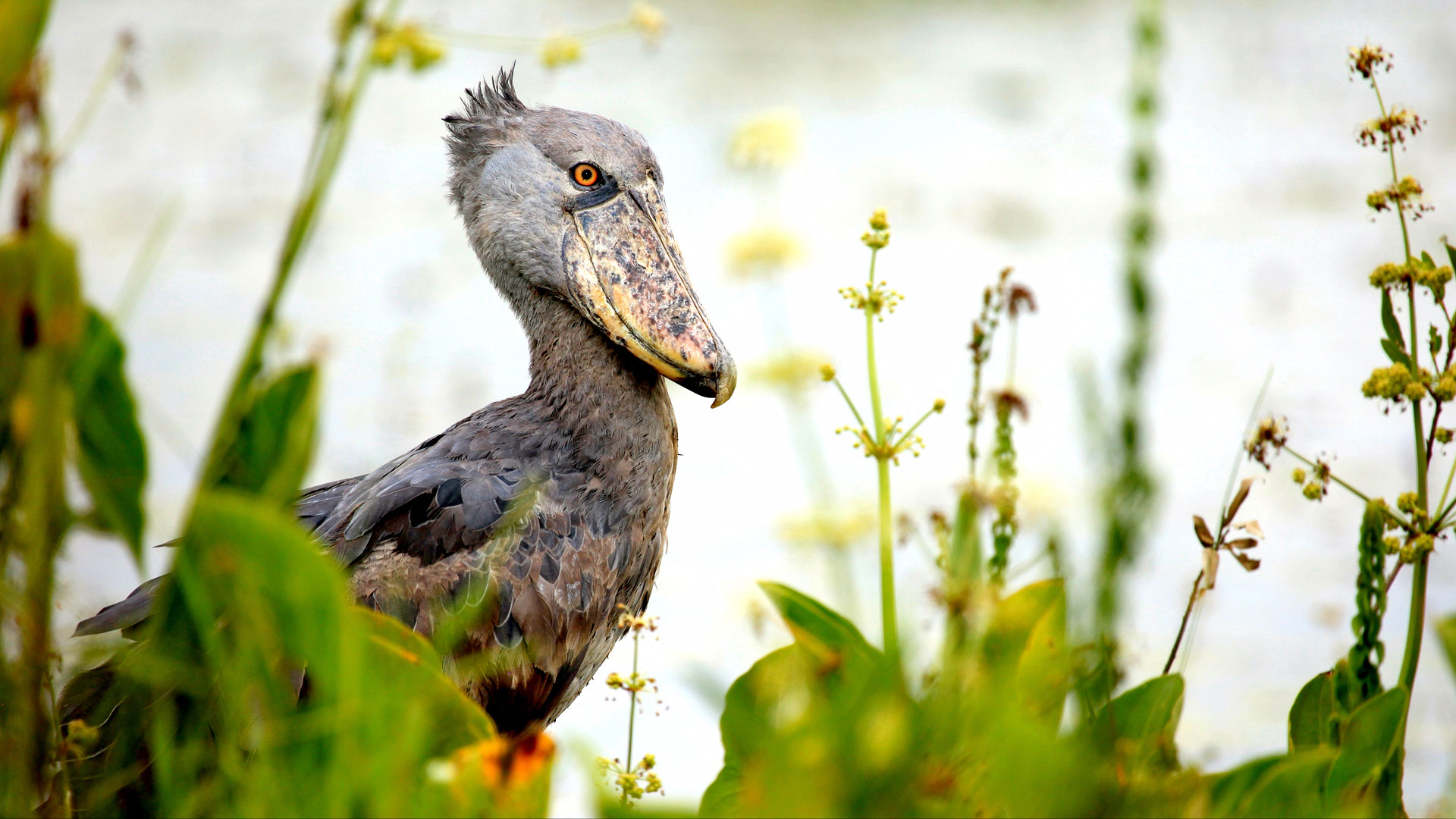- Home
- Conservancy
- The shoebill
Description
The shoebill is a tall bird, with a typical height range of 110 to 140 cm (43 to 55 in) and some specimens reaching as much as 152 cm (60 in). Length from tail to beak can range from 100 to 140 cm (39 to 55 in) and wingspan is 230 to 260 cm (7 ft 7 in to 8 ft 6 in). Weight has reportedly ranged from 4 to 7 kg (8.8 to 15.4 lb). A male will weigh on average around 5.6 kg (12 lb) and is larger than a typical female of 4.9 kg (11 lb).
The signature feature of the species is its huge, bulbous bill, which is straw-coloured with erratic greyish markings. The exposed culmen (or the measurement along the top of the upper mandible) is 18.8 to 24 cm (7.4 to 9.4 in). The sharp edges in the mandibles help the shoebill to decapitate their prey and also to discard any vegetation after prey has been caught. As in the pelicans, the upper mandible is strongly keeled, ending in a sharp nail. The dark coloured legs are fairly long, with a tarsus length of 21.7 to 25.5 cm (8.5 to 10.0 in).
The shoebill's feet are exceptionally large, with the middle toe reaching 16.8 to 18.5 cm (6.6 to 7.3 in) in length, likely assisting the species in its ability to stand on aquatic vegetation while hunting. The neck is relatively shorter and thicker than other long-legged wading birds such as herons and cranes. The wings are broad, with a wing chord length of 58.8 to 78 cm (23.1 to 30.7 in), and well-adapted to soaring. The plumage of adult birds is blue-grey with darker slaty-grey flight feathers. The breast presents some elongated feathers, which have dark shafts. The juvenile has a similar plumage colour, but is a darker grey with a brown tinge. When they are first born, shoebills have a more modestly-sized bill, which is initially silvery-grey. The bill becomes more noticeably large when the chicks are 23 days old and becomes well developed by 43 days.
Fun Facts
The shoebill is noted for its slow movements and tendency to remain still for long periods, resulting in repeated descriptions of the species as "statue-like". They are quite sensitive to human disturbance and may abandon their nests if flushed by humans. However, while foraging, if dense vegetation stands between it and humans, this wader can be fairly tame.
The shoebill is attracted to poorly oxygenated waters where fish frequently surface to breathe. Exceptionally for a bird this large, the shoebill often stands and perches on floating vegetation, making them appear somewhat like a giant jacana, although the similarly-sized and occasionally sympatric Goliath heron (Ardea goliath) is also known to stand on aquatic vegetation. Shoebills typically feed in muddy waters and, being solitary birds, forage at a minimum distance of 20 m (66 ft) from one another even where relatively densely populated.
This species stalks its prey patiently, in a slow and lurking fashion. While hunting, the shoebill strides very slowly and is frequently motionless. Unlike some other large waders, this species hunts entirely using vision and is not known to engage in tactile hunting. When prey is spotted, it launches a quick, violent strike. However, depending on the size of the prey, handling time after the strike can exceed 10 minutes.
Around 60% of strikes are successful in yielding prey. Frequently water and vegetation is snatched up during the strike and is spilled out from the edges of the mandibles. The activity of hippopotamus may inadvertently benefit the shoebill, as the hippos occasionally force fish to the surface of the water while they are submerged. Shoebills are largely piscivorous but are assured predators of a considerable range of wetland vertebrates. Preferred prey species have reportedly included marbled lungfish (Protopterus aethiopicus) and Senegal bichir (Polypterus senegalus) as well as various Tilapia species and catfish, the latter mainly in the genus Clarias. Other prey eaten by this species has included frogs, water snakes, Nile monitors (Varanus niloticus) and baby crocodiles. More rarely, turtles, snails, rodents and small waterfowl have reportedly been eaten
